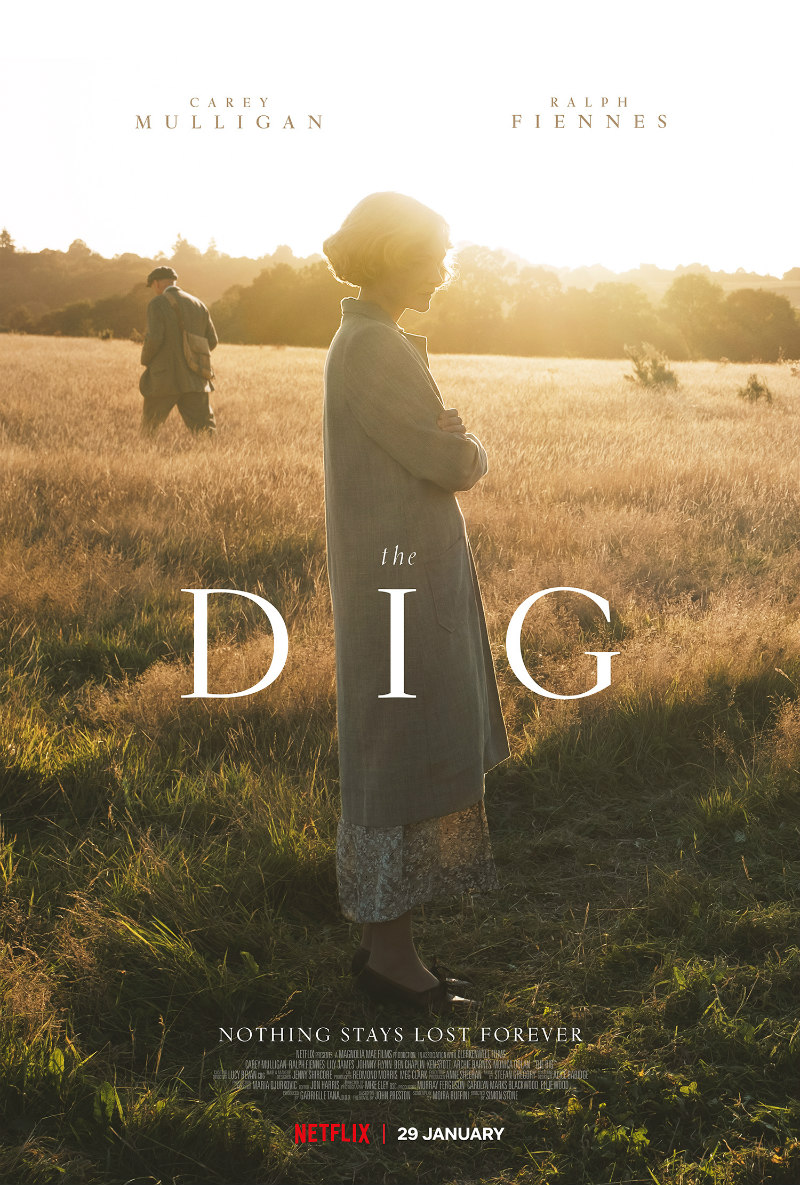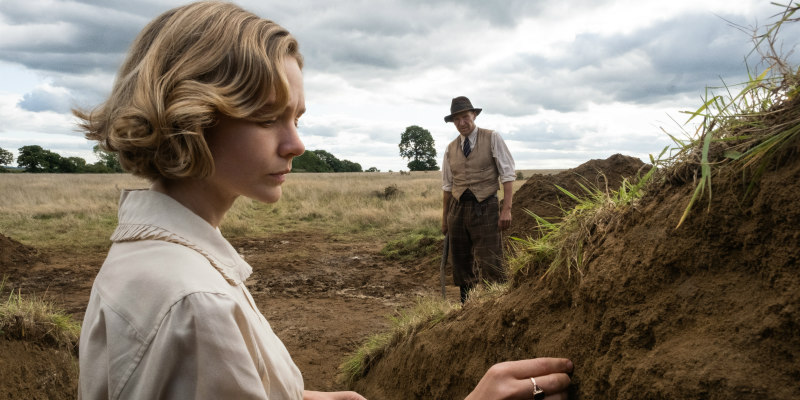
Review by
Eric Hillis
Directed by: Simon Stone
Starring: Carey Mulligan, Ralph Fiennes, Lily
James, Johnny Flynn, Ben Chaplin, Ken Stott, Monica Dolan

It's always nice when a role requires a millionaire actor to get their
hands dirty and perform some manual labour. Ralph Fiennes earns his
ploughman's lunch in director Simon Stone's adaptation of
John Preston's 2007 novel The Dig. As real-life archaeologist Basil Brown, he's constantly shovelling,
digging and dragging tarp across muddy fields in the middle of battering
rainstorms. Even Christian Bale might balk at the level of work required for
this part.
Set in 1939, with global conflict looming, The Dig sees the
working class Brown hired by wealthy widow Edith Pretty (Carey Mulligan) to excavate a series of what appear to be burial mounds on the land of
her estate. Edith has a "feeling" about one mound in particular, and though
it makes no logical sense to his reason-driven mind, Basil goes along with
her hunch, leading to an archaeological find that would come to be known as
"Britain's Tutankhamun", the discovery of a 6th century Anglo-Saxon ship and
its many treasures.

The first half of Stone's film is a fascinating character study of an
unappreciated man. Basil Brown's work at the Sutton Hoo estate went
unacknowledged until well after his death, and Stone and Fiennes appear
committed to delivering some restorative justice for Brown. It may be a
movie populated by quietly spoken and well-mannered protagonists, but
there's a real anger in terms of Brown's treatment at the hands of the
snobbish elites of the archaeological world who wish to appropriate his
discovery for themselves. As a self-taught man with no letters after his
name, Brown struggled to take his rightful place in the world of
archaeology, disparaged as a mere "excavator" despite having written books
on the subject, along with that of astronomy. What makes this aspect of
The Dig all the more effective is how it avoids anachronistic
behaviour on the part of Basil and Edith. As a working class man and a
woman, they're both well aware of their respective glass ceilings in 1930s
Britain, and their quiet resignation to such a raw deal is far more
impactful and anger-inducing than any rambunctious social justice storyline
might have been.
Unfortunately, this study of class is but one subplot in a film that, much
like an archaeological dig, seems to begin with only a vague idea of what
it's setting out to uncover and chisels away at various other, far less
involving subplots hoping to find treasure within. Mulligan was a late
replacement for Nicole Kidman, which is odd given how they're a full
generation apart. It seems the original draft may have focussed on a sexual
tension between Edith and Basil, as there are still remnants of this idea to
be found in the finished product. There's a very out of place five minute
sequence where Edith sulks upon learning of Basil's wife, despite their
relationship being portrayed as purely platonic for the rest of the
film.

Out of nowhere, Edith receives a fatal medical diagnosis which turns her
into a near cripple despite having been bouncing around prior to that point.
The introduction of a subplot concerning Lily James as an
archaeologist, Ben Chaplin as her closeted gay husband, and
Johnny Flynn as the former's dashing lover derails much of the film's
second half, sidelining Fiennes and Mulligan in favour of a storyline that
would require a movie of its own to explore in any depth. You get the sense
that with no romance between Edith and Basil, the producers insisted on
adding some spice to what they likely assumed would otherwise be a dull tale
of shovelling. This subplot also raises the issue (recently discussed in
regards to
Ammonite) of how unseemly it is to speculate on the private lives of real life
figures. James and Chaplin are playing Peggy and Stuart Preston, a real life
couple who did eventually divorce after 18 years, but there's no documented
evidence of the latter's sexuality having anything to do with the matter. If
Stuart was heterosexual, as appears to be the case, then this is a cheap
manipulation of the facts for the sake of drama. If he was homosexual, then
the film's portrayal of him as something of a villain for remaining closeted
(it's 1939!!!) while leading his wife on leaves an even more bitter
aftertaste.
Just as he can't decide which story to tell, Stone seems torn between two
filmmaking styles. For the most part The Dig is a handsome but
conventionally mounted piece of British prestige cinema, yet every now and
then Stone goes all Terence Malick with swooping handheld shots and editing
that will have viewers wondering if the dialogue has gone out of sync. He's
no Malick, but with the aid of cinematographer Mike Eley, Stone does
capture the beauty of rural England with lots of magic hour filming.

But for all the lush fields and pretty young actresses with quivering lips,
it's the face of Fiennes that provides The Dig with its
greatest visual splendour. The actor buries himself in the part of Basil
Brown, a man he clearly has lot of respect for, and you can almost see the
decades of soil caked between the creases of a brow that has been furrowed
too often for a man of his talent. If an astute fan editor were to excise
the pointless subplots that hinder The Dig and focus entirely
on the story of a man who has given up expecting acknowledgement and grown
to accept his work as its own reward, well, that would be a worthy
excavation of its own.


